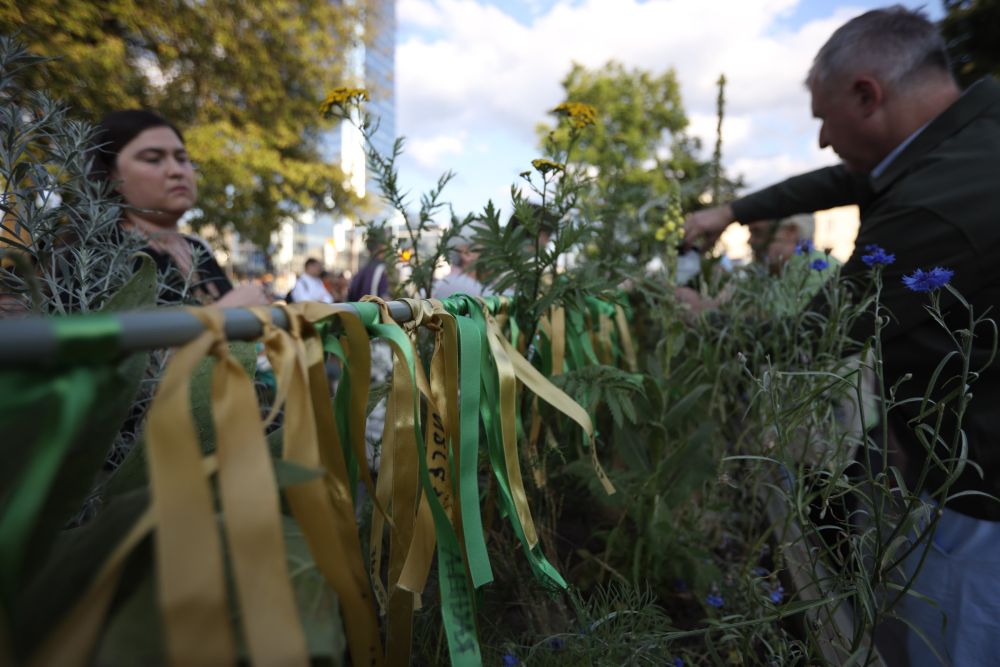- News
- Events
- Oneg Shabbat
- Collections
- Research
- Exhibitions
- Education
- Publishing Department
- Genealogy
- About the Institute
- Bookstore


fot.. Grzegorz Kwolek, the JHI
The March gathered hundreds of participants from Warsaw, Poland and abroad. Representatives of the highest state authorities were present at the event, including the Secretary of State in the Chancellery of the President of the Republic of Poland Wojciech Kolarski, Ambassador of the State of Israel Yacov Livne, Deputy Mayor of Warsaw Aldona Machnowska-Góra, representatives of the diplomatic corps, local government authorities, Jewish, state and local government institutions from Poland and abroad. This year we painfully felt the absence of Prof. Paweł Śpiewak, former director of the JHI, one of the initiators of the idea of the March, who was with us on that day for years and passed away on March 30, 2023.
“On July 22, 1942, 6,250 people left for their deaths in Treblinka. No one called for the rebellion, the head of the Jewish Council committed suicide. This day was the day of the Tisha B'Av religious fast commemorating the destruction of the Jerusalem Temple. The murder of hundreds of thousands of people was the destruction of thousands of little temples of life. Let us think about the victims of the Holocaust, let us pray, meditate and remember. It may seem that the decades that have passed since the war erase the memory of the victims of the German genocide during World War II. But we, as the Emanuel Ringelblum Jewish Historical Institute, will remember, against all odds and despite everything”, said Monika Krawczyk, the director of the Jewish Historical Institute.
This year's March, we dedicated to the resistance in the Warsaw Ghetto. The deportations in the summer of 1942 were a turning point for the Jewish resistance movement, which operated and developed in the ghetto from the very beginning of its existence. Łukasz Lewandowski, who conducted the ceremony, read out an excerpt from the memoirs of Cywia Lubetkin, a resistance activist:
“We sat down, (…) distraught. What to do? (…) Some said to attack with bare hands, sticks, whatever was at hand (…). We will organize mass demonstrations and we will not give in, even if the Germans start shooting at us. (…) We thought that perhaps our desperate act would spread the word of the slaughter to the outside world.”
Michel Gourary, director of the European March of the Living, also spoke during the ceremony:
“Two months ago, my beloved mother, Myriam, passed away at the age of 100 and half years and from her legacy, I learned about the courageous Righteous among the Nations. From my father’s legacy, I learned about the courage of the Jewish and non-Jewish Resistance fighters and partisans. I am bearing the name of my grandfather who was a forced labor slave of the Nazis for four long years. «The message of the March of the Living is a universal one: Get to the roots of hate, prejudice and intolerance, and eradicate them. Speak out against antisemitism, racial bigotry and racial violence wherever they may occur». Never means never.”
Then, Rabbi Icchak Rapoport said a prayer for the dead El male rachamim (God full of mercy) in Hebrew and Polish, and then the March set off from the Umschlagplatz monument and walked through the streets of Muranów district. Participants carried Ribbons of Remembrance with the names of Jewish residents of Warsaw written on them.
“Warsaw lost ⅓ of its inhabitants in the German deportation operation,” said director Monika Krawczyk. “It is estimated that nearly 300,000 Jews living in the closed district of Warsaw were murdered in death camps. To a large extent, we do not know what their names were, which is why we carry Ribbons of Remembrance with their names written on them, symbolically bringing their memory back to life. Poland remembers the Holocaust, Warsaw remembers its inhabitants.”
The march ended on the Square of the Scout Battalion of the Home Army “Wigry” next to the Muranów Cinema, where the outdoor exhibition “Roots of the Uprising. The Resistance in the Warsaw Ghetto”. The exhibition, which is a flowerbed with plants that were growing over the rubble of the Warsaw Ghetto, tells the story of Jewish resistance during World War II. Participants of the March hung the Ribbons of Remembrance among flowers. The Ribbons will be part of the exhibition until its closing on September 21, 2023.
At the end, the VRC Choir, conducted by Anna Waligóra-Tarnowska, performed four songs of resistance in Yiddish, which were sung by the inhabitants of the ghetto: “Der hoyfzinger fun warshewer ghetto”, a song by a street singer who curses the ghetto and its creators; “Warshe”, a call for revenge, written in January 1944, a year after the first act of armed resistance in the Warsaw Ghetto; “In kamf” (In action), pre-war song of rebellion against persecution. The last song “Yugnt himen” (Hymn of the Youth), written especially for the youth locked up in the ghetto, was full of hope for a new, better world.
Thank you for honouring with us the victims of the Warsaw Ghetto.
Honorary patronage: The Honorary Patronage over the March of Remembrance was taken by the President of the Capital City of Warsaw of Warsaw.
Partners:
EMOTL European March of the Living
Warsaw Ghetto Museum
POLIN Museum of the History of Polish Jews
Socio-Cultural Society of Jews in Poland
Jetline
Media patronage:
Onet
Polskie Radio Profram II
TVN24
Financing:
The exhibition “Roots of Uprising. Resistance in the Warsaw Ghetto” is funded by Iceland, Liechtenstein and Norway under the EEA Fund and by the national budget #EEAGrants #Funduszenorweskie #EEA #EEANorwayGrants
![ZDK 2022 B ENG.png [24.13 KB]](/storage/image/core_files/2023/1/24/ab665fe52719689c5033262de4e786cb/png/jhi/preview/ZDK%202022%20B%20ENG.png)